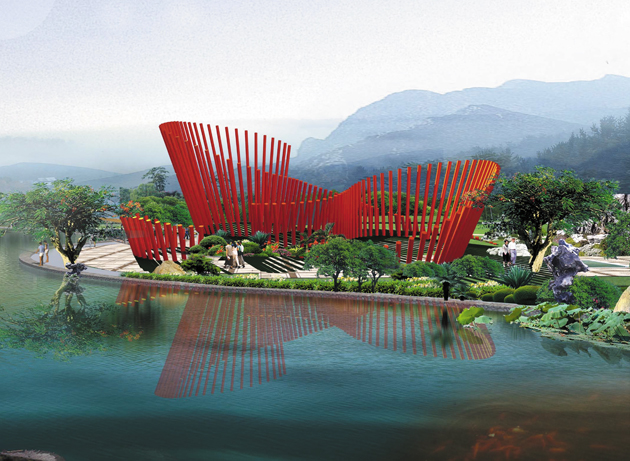Dancing with Dragons
A San Diego artist perfects the slow waltz of working in China

The Chinese have a word, han hwa, for the foreigner who fully assimilates into the Chinese culture.
Earning that rare accolade takes time, fortitude, resilience and a quality not always prized in America – willingness to find the middle ground.
San Diego artist Robert Mansfield can’t pinpoint the date he became han hwa. His fascination with things Chinese predates the public art he created for Shanghai in 2001; predates his marriage to Mingya, a Hangzhou native; predates even his first bittersweet experience living in China as a visiting artist from San Diego State University.
Now, 21 years later and still an SDSU professor of art, Mansfield is a finalist in the international competition to create public art for the Beijing Olympiad Sculpture Park. His monumental sculpture would serve as foil to the most daring Olympic venues ever built, Beijing’s National Aquatics Center (the water cube) and National Stadium (the bird’s nest).
Mansfield’s “Map of Time,” one of 2,400 original entries, comprises 256 micro etched titanium and carbon filter rods. Each one protruding 16 meters upward, the rods sway in the wind like sheaves of wheat and are lit at the top with multi-colored, computer programmed LED (light emitting diode) lights. A circular pool at the base of the sculpture represents the sky, while the square formation of rods is symbolic of the earth. The rods are reflected in the pool, connecting earth to sky.
Prosperity and public art
China’s willingness to finance large-scale, costly public art like “Map of Time” speaks volumes about the country’s ambitions as host of the 2008 Olympic Games. This is China’s opportunity to demonstrate leadership and progressivism to a skeptical world.
“Of course Beijing would like to use the Olympic Games as a great opportunity toshow the world a positive image of a country with rich and diverse culture and a fast-growingyet steady economy,” said Shengtian Zheng, managing editor of the Toronto-based Yishu Journal of Contemporary Chinese Art.
The connection between civic prosperity and public spectacle is one that China has exploited in other settings.
In 2004, Mansfield’s 14-meter-high “Geometric Rhapsody” sculptures were selected to distinguish Suzhou Industrial Park, a Chinese-Singaporean version of Silicon Valley rising from bogs and rice fields. The 60-ton shapes of bright red, blue, green and yellow are boldly emblematic of technology and engineering.
Earlier this year, Jiangsu province on China’s east coast chose Mansfield’s design for a 30-meter sculptural clock tower to anchor its new technological city. The competition prospectus called for a monumental symbol containing both historical and contemporary elements of China. Mansfield’s sculptures exude the energy and dynamism he sees all over China.
“The pace of construction here is explosive, like in early 20th century America,” he said. “There’s a strong belief in the future. Look at the Olympic stadium – the bird’s nest. It’s a metaphor for giving birth to a new century.”
Native influences
The vibrant China of 2007 stands in sharp contrast to the drab, underdeveloped nation Mansfield encountered in 1986. Deng Xiaoping had replaced Mao Zedong as leader and was nudging the country toward economic reform, but Chinese living standards were still shockingly inferior to those in the Western world.
The young American professor adjusting to life in Hangzhou was suddenly aware of the high-tech society he had left behind. He stopped making art and began to re-examine his life and his work.
“In China, there is a much greater cultural consciousness about the importance of art in life than there is in the U.S.,” Mansfield said. “Look at their 7,000-year history; the Chinese have always understood the meaning of aesthetics.”
Returning to San Diego, Mansfield developed a new style, drawing on the influences of his native Minnesota. He realized that nature had always been a theme in his work, and he became more interested in the spaces between objects like grass or stalks of wild rice. He saw splendor in motion and magnetism and in the iridescence of dragonflies’ wings.
Mansfield also saw that technology could help him recreate natural elements and forces in his sculpture. Today, his work embraces high-tech materials like carbon fiber, etched titanium and LED technology. For advice on the use of lasers in “Map of Time,” Mansfield turned to William Tong, an SDSU biochemistry professor who holds patents in laser technology.
Bending like bamboo
If “Map of Time” is chosen for one of the precious sites in Olympic Park, city officials will almost certainly request modifications. Mansfield knows he may have to discard the element of water in the base because Beijing is experiencing a serious drought.
But, like the slender bamboo, which survives by bending with the wind, Mansfield has learned the art of compromise and concession.
He tells a story about working with engineers and city planners in 2000 on a sculpture for Long Life Park in central Shanghai. To reduce the cost of construction, the civil servants ordered inferior materials and altered the design without consulting Mansfield.
“When I found out, I was furious,” he recalled, “but they told me, ‘Professor, it’s not your problem.’ One evening, I visited the park and saw families dancing around the sculpture, using it in a way I hadn’t envisioned. The Chinese had been right. It wasn’t my problem.
“Years ago, I was inflexible. I wasn’t going to let people screw with my work. Now, I think it’s arrogant for an artist to believe his work has to be executed precisely as he intended. But I will fight to retain the parts worth fighting for.”
While Mansfield waits for a decision on the construction of “Map of Time,” he is taking a sabbatical in China. He, Mingya, and their young son, Brendan, will live in Hangzhou, where Mansfield will continue to teach and work and probe the soul of China.



